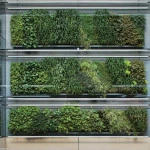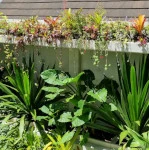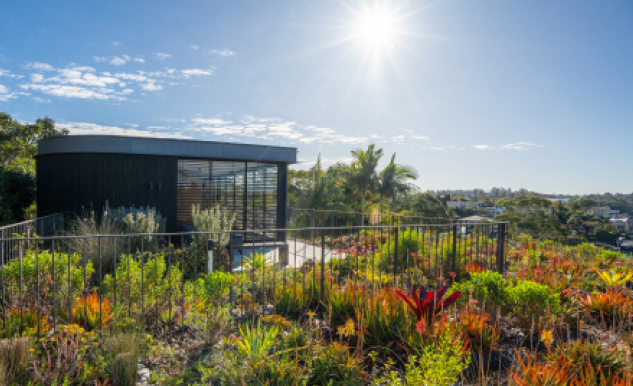5 Reasons we need more Greenroofs in our urban landscape.
As our cities continue to expand and urbanisation reaches unprecedented levels, the detrimental effects of urban heat islands and environmental degradation become more pronounced. It is imperative that we seek innovative and sustainable solutions to counteract these issues. One of these options is greenroofs! Our rooftops represent 21–26% of urban areas and 40–50% of their impermeable areas (Wong, 2005; Dunnett & Kingsbury, 2004). Rooftop gardens offer a multitude of benefits that not only mitigate the urban heat island effect but also positively impact air and water quality, biodiversity, and overall urban resilience – plus they provide a great outlook.
Let’s delve into five compelling reasons why we urgently need more greenroofs in urban landscapes in Australia.
- Tackling the Urban Heat Island Effect
Urban heat islands are a consequence of excessive heat retention in built-up areas, leading to higher temperatures compared to surrounding rural regions. This phenomenon exacerbates heatwaves and has severe consequences for public health, energy consumption, and urban ecosystems. Greenroofs act as a natural thermal insulator, reducing the amount of heat absorbed by buildings and their immediate surroundings. Research from Germany has shown that greenroofs can lower rooftop temperatures by up to 50°C during hot summer days, significantly mitigating the urban heat island effect.
- Enhancing Biodiversity and Ecosystem Services
Incorporating greenroofs into our urban landscape creates unique opportunities for fostering biodiversity corridors through our cities. These rooftop gardens provide essential habitats for various plants, insects, and birds that struggle to find a place in our concrete-dominated cities. Biodiversity not only improves the overall health of ecosystems but also enhances urban resilience to climate change impacts and pest management. Research studies have demonstrated the positive impacts of greenroofs on biodiversity, showing an increase in the abundance and diversity of native species.
- Promoting Air and Water Quality Improvement
Greenroofs play a vital role in improving air quality by filtering pollutants and capturing particulate matter from the atmosphere. The vegetation on greenroofs absorb and capture carbon dioxide, while the plants root system captures and consumes the harmful particulate matter that the water washes out of the atmosphere. Additionally, the natural evapotranspiration process from the plants helps cool the air. Moreover, greenroofs act as effective stormwater management systems, reducing the initial storm load flow and preventing urban drainage systems being overwhelmed. The plants and soil on greenroofs trap and retain rainwater, which is gradually released or absorbed, minimizing runoff and pollutants entering water bodies.
- Utilising Recycled and Sustainable Materials
Our greenroof systems can are constructed using a variety of eco-friendly and recycled materials, in fact 95% of the materials are recycled from here in Australia, reducing the demand for resource-intensive construction components and overseas shipping of recycled waste. Implementing sustainable practices during the installation of greenroofs further lessens the environmental footprint of urban development. By promoting the use of recycled materials and environmentally conscious construction methods, we can support a more circular and sustainable economy.
- Enhancing Building Energy Efficiency
The thermal insulation properties of greenroofs extend beyond mitigating the urban heat island effect. By reducing the heat absorbed by buildings, greenroofs aid in maintaining comfortable indoor temperatures, reducing the need for excessive air conditioning during hot weather. This, in turn, leads to decreased energy consumption, contributing to overall building energy efficiency and potentially lowering greenhouse gas emissions.
To recap, greenroofs offer a multitude of benefits that address the pressing environmental challenges faced by urban landscapes today. By mitigating the urban heat island effect, enhancing biodiversity, improving air and water quality, utilising sustainable materials, and promoting building energy efficiency, greenroofs prove to be an indispensable component of resilient and sustainable cities. As we look towards the future of urban development, embracing greenroofs should be a priority for planners, architects, and policymakers to create healthier, greener, and more liveable urban environments.
Reference:
Wong (2005) Green roofs and the Environmental Protection Agency’s heat island reduction initiative Proc. of 3rd North American Green Roof Conference: Greening Rooftops for Sustainable Communities, Washington, DC. 4–6 May 2005, The Cardinal Group, Toronto
Dunnett, N., & Kingsbury, N. (2010). Planting green roofs and living walls. Portland: Timber Press.






Pingback: Lightweight Greenroofs: Eco Pillows Let Mother Nature Sleep asy